
Issue 1043

BACK TO EDGAR RICE BURROUGHS'
TARZANA RANCH 1921
Part III: Illustrated Version
by Bill Hillman
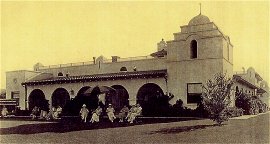


BACK TO EDGAR RICE BURROUGHS'
TARZANA RANCH 1921
Part III: Illustrated Version
by Bill Hillman

We found ourselves in a large, wood-paneled room that was dominated by a long, heavy dining table supported by squat, profusely carved legs. The chairs of matching wood carried on the ubiquitous Spanish theme. One side of the room opened into a breakfast room that had a great view of the valley and sprawling hills. Doors on the other side of the room opened into the kitchen and butler's pantry, where the kitchen staff were putting the last touches on meal preparation. A large archway led to the east wing living room from which Emma and the children emerged. We were directed to our places at the table and were soon enjoying the fruits of country labour: home-made bread, fresh churned butter, tall cool pitchers filled with rich Guernsey milk, ranch-raised beef, an endless array of garden produce: potatoes, corn, peas and tomatoes, and lettuce -- followed up with hot apple pie topped with cream so thick that we had difficulty pouring it.
Dinner talk ran the gamut: grand opera, the budding of the walnut trees, the latest popular novels and moving pictures, word games, the most practical method of earmarking pigs, new neighbours in the valley, horses, prohibition home-brew, the children's progress in their studies, Hully's ground squirrel hunting prowess with his .22 rifle, the latest film star gossip from Joan's schoolmates, Jack's adventures on his new pony . . . and so on. Our trio joined most discussions, but to the mild puzzlement of our hosts we shied away from telling too much about ourselves.
We came to appreciate that Tarzana Ranch ran like a small city. A very large staff was maintained because of the size of the residence, grounds and the great variety of agricultural activites. The maintenance bills must have been horrific. The payroll alone would be staggering: secretary, cook, housekeepers, groundskeeper, livestock foremen, maintenance man, ranch hands, farm hands, chauffeur, and probably many more lurking behind the scenes. Ed let it slip that he thought his writing royalties for 1921 would be around $100,000 but I wondered just how long an income of even this magnitude could support such a lifestyle -- and a ranch operation that was obviously far from being self-sustaining or working at anywhere near a profit. I had a nagging fear that, somehow, the overflowing happiness that this family so obviously shared was too good to last. But Ed's excitement over the joys of country living was infectious. His dinner comments were typical of the many thoughts he often expressed on the advantages of raising children in such an environment.
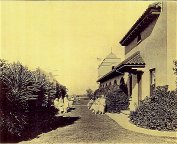
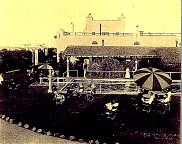
"We are so lucky to be able to raise our children in the country, where children are more dependent upon their sisters and brothers for companionship than children of the city. We all get better acquainted in the country and we have to learn to find the best that is in each of us, for we haven't the choice of companions here that a city, with its thousands, affords. The affection they show for each other is so perfect that there could never be any misunderstanding among them. We all rise early and are usually in the saddle before sunrise. Riding constitutes one of our principal diversions, a pastime from which we derive considerable pleasure. It's a happy, care-free life far from the strife and squalor of the city, and yet we enjoy more comforts and luxuries than most city dwellers ever experience. I also believe that this lifestyle promotes that characteristic so unique to the human mind -- imagination. Without imagination there is no power to visualize what we have never experienced, and without that power there can be no progress."We retired to the East-Wing living room for after-dinner refreshments. Whereas the family room in the West Wing might be described as the Jungle Room, this room was much more formal -- more like an English drawing room with a strong Asian influence. Natural light from the south entered the room through a large window and a glass panelled door with transom, all of which combined to frame a splendid view of the valley. Above, a long skylight in the high beamed ceiling flooded the room with sunlight. Artificial light was provided by a brilliant chandellier and numerous floor lamps with their giant, tasselled shades. The walls were lined with wooden, glassed-in display cases filled with first editions and ornaments. A grand piano, laden with stacks of music, books and a Chinese vase filled with fresh-picked flowers, commanded the southern side of the room. Scattered throughout the room were plush chairs and items of Chinese design and origin: end tables, rugs, ornaments, and lamps. On the west wall was another grandfather's clock and a sofa, while across the room was a huge, green-tiled fireplace and a large, ornately carved table.
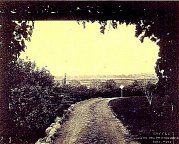 Ed, upon hearing a car come up the driveway, suggested that it was time for everyone to move to the ballroom. We learned that a regular Friday event, to which Ed issued a standing invitation to those living in and around the Rancho, was the showing of the latest Hollywood films. There was no theatre for miles around and it wasn't unusual for 150 to 200 people to gather here each week. He supervised the show from up in his projection room loft, where he chose the films and worked as projectionist. Usually the bill featured both a comedy and a drama. Tonight, however, was to be a very special night as Ed was debuting the finished full-length feature version of The Son of Tarzan -- the film he had edited himself from the serial version. I had learned from the dinner conversation that Ed's film editing room was a great source of amusement to the family. He had sequestered himself in the tiny room for many days and weeks. Visitors to the room marvelled at the maze of cables strung across the room from which hundreds of strips of film were suspended -- numbered and collated in some cryptic system known only to Ed Burroughs, the movie mogul.
Ed, upon hearing a car come up the driveway, suggested that it was time for everyone to move to the ballroom. We learned that a regular Friday event, to which Ed issued a standing invitation to those living in and around the Rancho, was the showing of the latest Hollywood films. There was no theatre for miles around and it wasn't unusual for 150 to 200 people to gather here each week. He supervised the show from up in his projection room loft, where he chose the films and worked as projectionist. Usually the bill featured both a comedy and a drama. Tonight, however, was to be a very special night as Ed was debuting the finished full-length feature version of The Son of Tarzan -- the film he had edited himself from the serial version. I had learned from the dinner conversation that Ed's film editing room was a great source of amusement to the family. He had sequestered himself in the tiny room for many days and weeks. Visitors to the room marvelled at the maze of cables strung across the room from which hundreds of strips of film were suspended -- numbered and collated in some cryptic system known only to Ed Burroughs, the movie mogul.Partway into the film the audience erupted into spontaneous applause as they greeted the screen appearance of a familiar-looking rider on a sleek mount. From the shouts that filled the room I realized that I was witnessing the screen debut of our host: "Ride him Ed!" "Look at the Colonel!" "Mommy, Look! It's Mr. Burroughs!" "Gosh, Tom Mix ain't got nothin' on OB!" At the end of the film Ed gave a polite wave from the projection booth in response to the enthusiastic applause of his audience. This was the signal to move back the chairs to open a space for dancing.
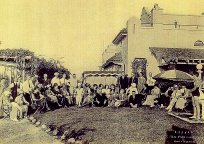 John Shea wheeled out the gramophone and within minutes people of every age were dancing to the latest hits of 1921: 12th Street Rag, The Bells of St. Mary's, Crazy Blues, Give a Man a Horse He Can Ride, and many more I didn't recognize. Ed, invoking host privilege, occasionally managed to work in some of his favourites, mainly light opera and Sousa military march recordings. The multi-talents of the Burroughs family were further displayed when Emma sat down at the Heintzman upright, where she accompanied herself, Joan and Hulbert in a couple of well-received performances.
John Shea wheeled out the gramophone and within minutes people of every age were dancing to the latest hits of 1921: 12th Street Rag, The Bells of St. Mary's, Crazy Blues, Give a Man a Horse He Can Ride, and many more I didn't recognize. Ed, invoking host privilege, occasionally managed to work in some of his favourites, mainly light opera and Sousa military march recordings. The multi-talents of the Burroughs family were further displayed when Emma sat down at the Heintzman upright, where she accompanied herself, Joan and Hulbert in a couple of well-received performances.
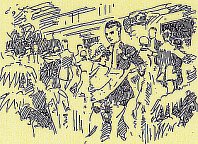
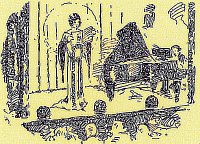
The revellers started to drift back to the valley at twilight, well aware that the Burroughs family always arose before daybreak. The coming of sunset was also the cue for the Burroughs family to gather around the flagpole on the east lawn to take part in the nightly ritual of lowering the Stars and Stripes.
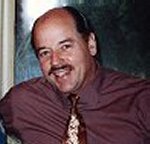 |
Memories from the Danton Burroughs Family Album |

. WEBJED: BILL HILLMAN .

Visit our thousands of other sites at:
BILL AND SUE-ON HILLMAN ECLECTIC STUDIO
ERB Text, ERB Images and Tarzan® are ©Edgar Rice Burroughs, Inc.- All Rights Reserved.
All Original Work ©1996-2003/2010/2022 by Bill Hillman and/or Contributing Authors/Owners
No part of this web site may be reproduced without permission from the respective owners.